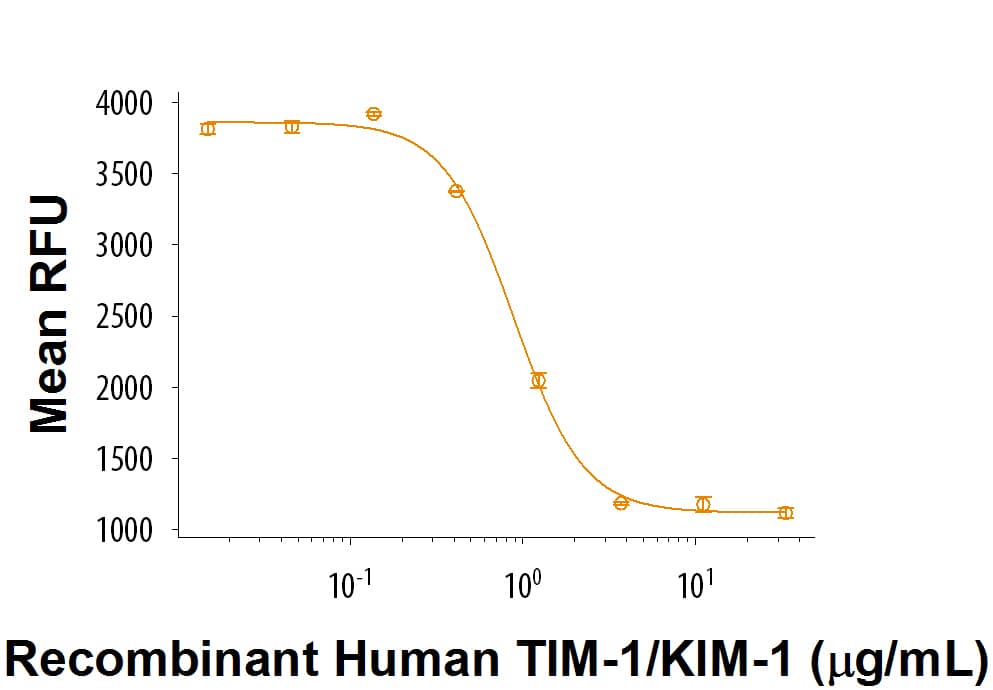Recombinant Human TIM-1/KIM-1/HAVCR Fc Chimera Protein, CF
R&D Systems, part of Bio-Techne | Catalog # 9319-TM
(268 aa)

Key Product Details
Source
HEK293
Accession #
Structure / Form
Disulfide-linked homodimer
Conjugate
Unconjugated
Applications
Bioactivity
Product Specifications
Source
Human embryonic kidney cell, HEK293-derived human TIM-1/KIM-1/HAVCR protein
| Human Tim-1/Kim-1/HAVCR (Ser21-Thr288) Accession # AAC39862 |
IEGRMD | Human IgG1 (Pro100-Lys330) |
| N-terminus | C-terminus |
Purity
>85%, by SDS-PAGE visualized with Silver Staining and quantitative densitometry by Coomassie® Blue Staining.
Endotoxin Level
<0.10 EU per 1 μg of the protein by the LAL method.
N-terminal Sequence Analysis
Ser21
Predicted Molecular Mass
55 kDa
SDS-PAGE
112-129 kDa, reducing conditions
Activity
Measured by its ability to inhibit anti-CD3-induced proliferation of stimulated human T cells.
The ED50 for this effect is 0.6-3.6 μg/mL.
The ED50 for this effect is 0.6-3.6 μg/mL.
Scientific Data Images for Recombinant Human TIM-1/KIM-1/HAVCR Fc Chimera Protein, CF
Recombinant Human TIM-1/KIM-1/HAVCR Fc Chimera Protein Bioactivity
Recombinant Human TIM‑1/KIM‑1/HAVCR Fc Chimera (Catalog # 9319-TM) inhibits anti-CD3-induced proliferation of PHA-activated human T cells. The ED50 for this effect is 0.6-3.6 μg/mL.Formulation, Preparation and Storage
9319-TM
| Formulation | Lyophilized from a 0.2 μm filtered solution in PBS. |
| Reconstitution |
Reconstitute at 500 μg/mL in PBS.
|
| Shipping | The product is shipped at ambient temperature. Upon receipt, store it immediately at the temperature recommended below. |
| Stability & Storage | Use a manual defrost freezer and avoid repeated freeze-thaw cycles.
|
Background: TIM-1/KIM-1/HAVCR
References
- Du, P. et al. (2016) J. Immunol. Res. 2016:8605134.
- Feigelstock, D. et al. (1998) J. Virol. 72:6621.
- Ding, Q. et al. (2011) J. Clin. Invest. 121:3645.
- Ma, J. et al. (2011) Biochem. Biophys. Res. Commun. 406:223.
- de Souza, A.J. et al. (2005) Proc. Natl. Acad. Sci. USA 102:17113.
- Kuehn, E.W. et al. (2002) Am. J. Physiol. Renal Physiol. 283:F1326.
- Umetsu, S.E. et al. (2005) Nat. Immunol. 6:447.
- Xiao, S. et al. (2011) Eur. J. Immunol. 41:1539.
- Ichimura, T. et al. (1998) J. Biol. Chem. 273:4135.
- Bailly, V. et al. (2002) J. Biol. Chem. 277:39739.
- Kondratowicz, A.S. et al. (2011) Proc. Natl. Acad. Sci. USA 108:8426.
- Miyanishi, M. et al. (2007) Nature 450:435.
- Kobayashi, N. et al. (2007) Immunity 27:927.
- Yamanishi, Y. et al. (2010) J. Exp. Med. 207:1501.
- Meyers, J.H. et al. (2005) Nat. Immunol. 6:455.
- Tami, C. et al. (2007) J. Virol. 81:3437.
- Lee, H.H. et al. (2010) J. Immunol. 185:5225.
Long Name
T Cell Immunoglobulin Mucin-1
Alternate Names
CD365, HAVCR1, KIM-1, TIM1
Gene Symbol
HAVCR1
UniProt
Additional TIM-1/KIM-1/HAVCR Products
Product Documents for Recombinant Human TIM-1/KIM-1/HAVCR Fc Chimera Protein, CF
Product Specific Notices for Recombinant Human TIM-1/KIM-1/HAVCR Fc Chimera Protein, CF
For research use only
